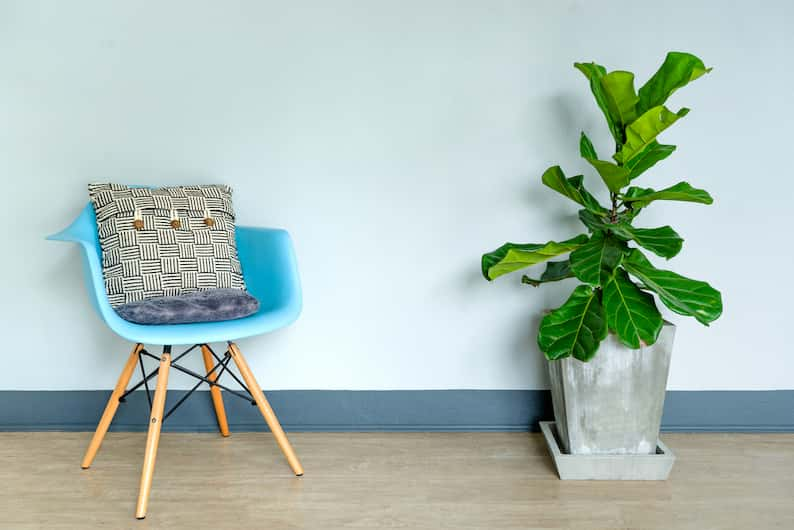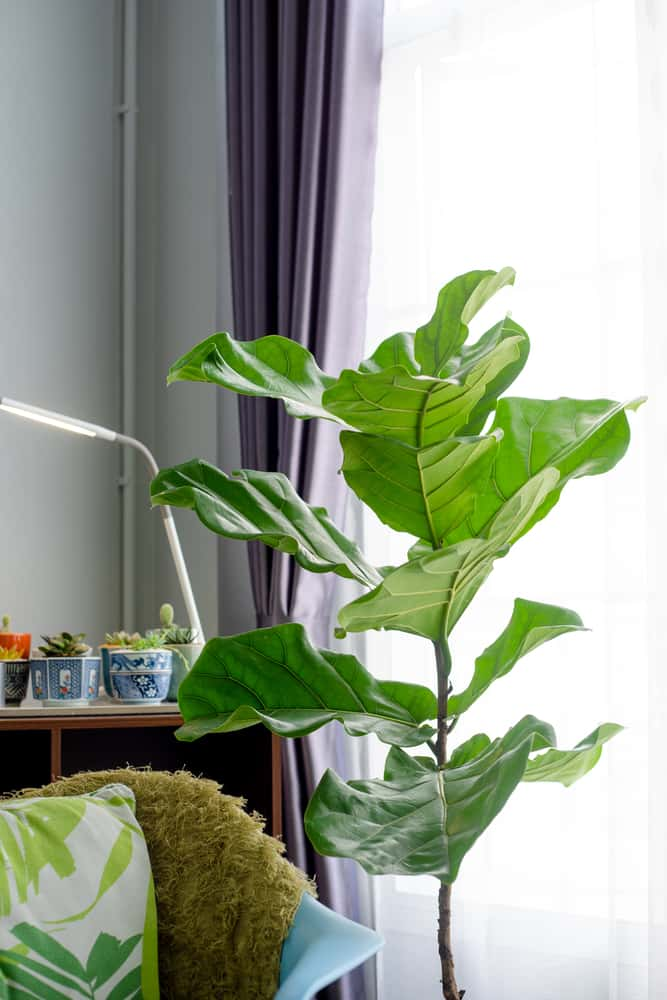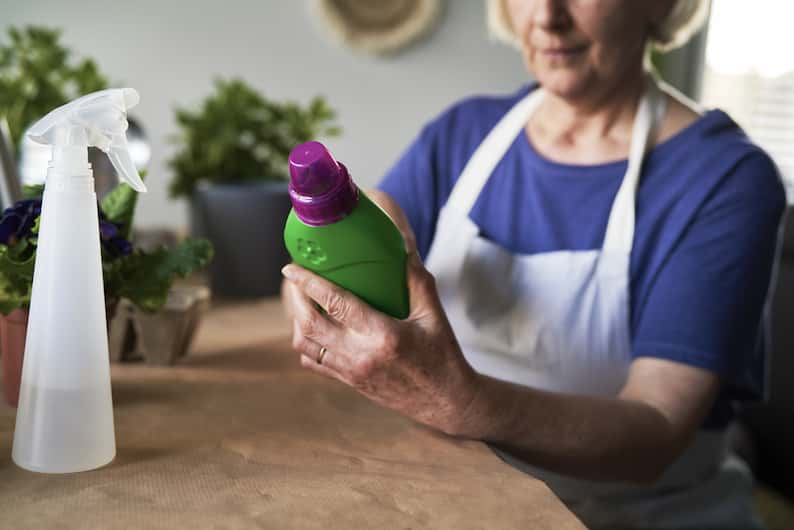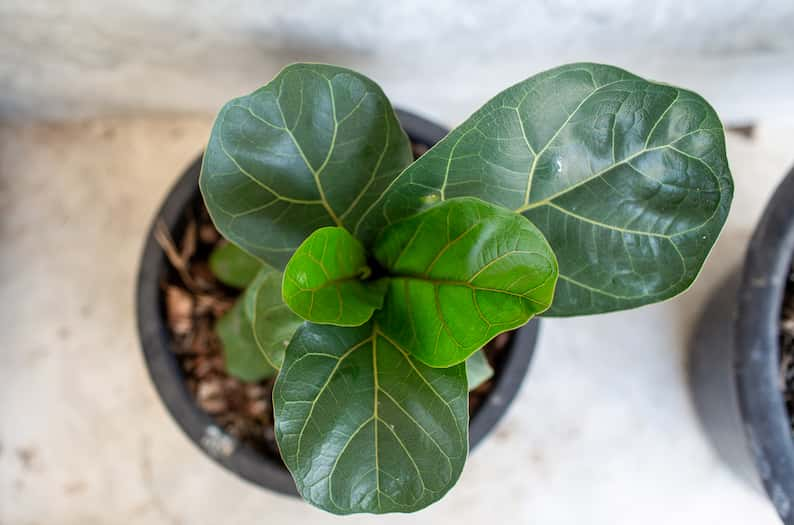When it comes to the magnificent Ficus lyrata, I can personally attest to how difficult it is to be patient regarding their growth. This is because there is no definitive answer to the question of how fast do fiddle leaf figs grow. Conversely, these sensitive plants have a penchant for marching to a beat of their own, with so much of how they behave depending on their growing environments and overall health.
With their discerning natures in mind, it can be argued that the reward of a well-growing fiddle leaf is borderline indescribable. What could be better than the appearance of a few shiny new light green leaves, particularly after a period of dormancy? However, to get there, you need to ensure all your plants’ needs are met.
Part of this article will focus on how to make your fiddle leaf figs grow faster, while other sections explore general observations around their growth speed. We’ll also look at the comparative growth of indoor fiddle leaf figs versus outdoor fiddle leaf figs, as well as between different cultivars.

Table of Contents
How fast do fiddle leaf figs grow?
In prime condition, fiddle leaf figs have been known to grow between one to three feet per year. However, the growth speed of fiddle leaf figs depends on how optimal their environments are. With the right sun, humidity and water and feeding schedule, you’ll likely see new growth every few weeks during spring and summer.
On the other hand, a minor misstep will prevent your plant from producing new growth, and even though it may appear healthy, you’ll find that it struggles to bring forth additional leaves. So how can we prevent this?
Ultimately, the first step is to understand which factors play a role in helping your plants to grow. Of course, water, light, and fertilizer will impact growth, but so does ensuring you’re using the best soil for your fiddle leaf fig, controlling the humidity levels, and, very importantly, your pruning regime. An unhappy or unhealthy fiddle leaf fig is far less inclined to gain any significant growth.
A further factor impacting the growth speed of fiddle leaf figs is whether they’re established or not (put another way: bigger plants get bigger faster) and if they’re based indoors or outdoors. Fiddle leaf fig trees acclimated to direct sun, for example, are more inclined to thrive in bright, light spots than those that have been living indoors for the duration of their lives.
Are fiddle leaf figs slow-growing?
Fiddle leaf figs have a moderately slow growth rate, even when performing at their best. The Ficus lyrata is first and foremost a jungle plant, having originated in West Africa. Their natural tropical environments are almost impossible to imitate in a home or garden setting, impacting their growth.
While these gorgeous greens have adapted beautifully to domestic living, they cannot be expected to thrive the way they do in their natural settings. Instead, a high growth rate in a commercially-grown fiddle leaf fig is anything above a foot per year. If you’re seeing this kind of height, you’re doing something right.
Even so, don’t let this discourage you. While your fiddle leaf figs adapt to their new living spaces, you won’t see much new growth, particularly in the first year or two. Once established and when well-looked after, however, your tree will start to thrive.
How fast do fiddle leaf fig trees grow indoors?
A happy and established indoor fiddle leaf fig tree will grow around two feet in height each year and can gain over a dozen new leaves over that time. The speed at which indoor fiddle leaf figs grow depends on their overall health, age, and where they are situated. It also depends on the season.
As previously mentioned, the successful growth of a fiddle leaf fig depends very much on being well looked after. Still, one benefit of growing these lovely plants indoors is that it’s easier to control their environments. Inside, fiddle leaf figs are not exposed to the elements and fluctuations in temperature.

In addition, you can closely monitor them for potential diseases or pests, control your fiddle leaf fig’s fertilizer intake and the humidity levels surrounding them, and make sure they receive adequate water and light. The flip side of this is that one wrong move can leave them refusing to grow at all.
Indoor fiddles can be stubborn, and you’ll need to commit to the long game. On occasion, however, you hit a sweet spot and can see exceptional growth right from the start. In my personal experience, they can take up to three years to settle in a particular location indoors before experiencing a significant growth season.
How can I make my fiddle leaf fig grow faster?
The only way to bolster the growth speed of fiddle leaf figs is to tend to their needs accurately and consistently. How well you care for your fiddles will directly impact how fast they grow. Key care factors include adequate light, water, and fertilization, pruning, and humidity.
At the end of the day, caring for fiddle leaf figs is straightforward, but it does require regularity and consistency. These plants are very resistant to change and will express their displeasure by stalling their growth, wilting, or drooping. To make your fiddle leaf fig grow faster, you need to tick the following boxes care-wise.
1. Provide plenty of bright, indirect light
Most plants rely on the sun to grow, and the fiddle leaf fig is no different. This plant needs 6 to 8 hours of indirect light per day, preferably morning sun, that isn’t too harsh on its leaves. Without sufficient light, your fiddle leaf won’t have the energy to produce new leaves.
The best practice for indoor fiddle leaf figs is a location close to an east- or south-facing window. If you habitually move your fiddle leaf fig outdoors for direct sun, make sure to acclimate it first to prevent shocking its system and stunting its growth in that way.
Related: What Are Your Fiddle Leaf Fig’s Light Needs?
2. Establish a consistent watering schedule
The sheer size of a Ficus’ leaves is enough for us to know that they require quite a bit of water, but given how vulnerable your fiddle leaf fig is to root rot, there is a fine line between having a suitably watered and an overwatered fiddle leaf fig.
In terms of how often to water your fiddle leaf fig, a good watering schedule involves giving a top-up every 7 to 10 days. However, this is a general rule, and a better way to go about watering your fiddles is to wait until the top inch of soil has dried. Just be careful not to wait too long, as having an underwatered fiddle leaf fig can also come with its own range of problems.
3. Make sure to feed your fiddle leaf fig regularly
To boost your fiddle leaf fig’s growth, offer them a little help in the form of fertilizer. As mentioned, indoor environments are not at all similar to how the fiddle leaf fig grows in the wild, so it follows that it will require a little nutrient boost now and then.
During their growing seasons (spring and summer), fiddle leaf figs can be fed every few weeks, fertilizer dependent.

4. Pruning is key
I cannot overstate the importance of pruning. While it seems counter-intuitive to cut away growth when you’re trying to boost it, pruning is a vital part of keeping your plant healthy, making way for new buds, and shaping it to your satisfaction (in fact, if your fiddle leaf fig grows multiple stems, you can even braid it!).
Prune your fiddle leaf figs only during their growing season so that they have the energy to form new buds and stems. On that note, don’t be alarmed if your fiddle doesn’t grow during autumn and winter. This is their period of dormancy.
5. Improve your fiddle leaf fig’s access to humidity
Some like it hot, including the fiddle leaf fig. These plants are more inclined to thrive in locations with medium to high humidity and where they are away from drafts and air conditioners. As with fertilizer, you can offer a little artificial help in this regard.
In other words, a humidifier is a great addition to your fiddle leaf fig’s environment. Try to keep one close to your plant, especially in cooler spaces.
6. Consider their overall health and happiness
Even with your best efforts, a plant suffering from ill health will have difficulty producing new growth. For this reason, you must check your fiddles regularly for signs of distress, including drooping, wilting, and brown spots on your fiddle leaf fig’s leaves.
It may be that they simply don’t like where they’re situated or that something else is amiss, like a bacterial or fungal infection.
How often do fiddle leaf figs grow new leaves?
During the spring and summer months, it’s not unusual for fiddle leaf figs to grow two to three new leaves every couple of weeks. Over the course of a year, this can translate to a fair few feet in height, or in the case of more compact dwarf fiddles, a bushier, more dense appearance.
When a fiddle leaf is really thriving, its growth can be tremendously gratifying, and you’ll often find you’re treated to a set of new buds every 3 to 4 weeks. When this happens, it’s usually because care is excellent, and your fiddle has been pruned in such a way that new growth is encouraged.

I touched on this in the previous section, but it’s worth mentioning again. Excellent care aside, pruning can be a great way to encourage growth. Bud pinching and cutting above the nodes is a way to coax your plant into producing leaves (but should be performed with care).
Indeed, don’t be alarmed if your fiddle leaf fig is dropping leaves during its growing season too (although having a fiddle leaf fig with no leaves is cause for concern). This is a natural process whereby the old makes room for the new, and a relative number of lost leaves can be expected. Too many, on the other hand, and you may need to inspect your plant for other issues.
On this topic, it must also be noted that growth can be cultivar-dependent. Standard fiddle leaf fig varieties grow fastest, whereas dwarf fiddle leaf figs are slightly slower, particularly as their new leaves tend to cluster around the stem. Hybrids and rare cultivars like variegated fiddle leaf figs take even longer to grow.
FYI: To encourage new growth, why not try notching your fiddle leaf fig?
How long do fiddle leaf fig leaves take to grow?
It takes less than a week for fiddle leaf fig leaves to grow from bud to fully-formed leaf. Buds present as small outgrowths in papery brown coverings. Once unfurled, leaves are small, flimsy, and light green. From this point, they need a few extra days to reach their full size, turning a dark, waxy emerald.
There are few things more satisfying than a crop of fresh buds on a fiddle leaf fig, particularly if you’ve been waiting a long time for it to grow. The best part is that, with all things going to plan from this point onwards, it’s only a short time until your leaves are fully formed.
At the height of their growing season, fiddle leaf figs might produce up to four leaves every few weeks. This is a sign of a truly flourishing plant. On the other hand, you may only see one new leaf, which is usually the case with smaller plants.
Either way, new growth is a good sign. Keep up proper care, and your plant will continue to thrive as it grows bigger and stronger. In no time, you’ll be adding a few feet each year.
Final thoughts
When you have a houseplant like this that’s known for its impressively large, glossy leaves, it’s only natural to want to know how fast do fiddle leaf figs grow – not to mention how to make it grow even faster!
Like many things though, it’s a case of if you treat them nicely, they’ll likely behave. Unfortunately, the fiddle leaf fig can be a bit picky at the best of times, so you will have to find the delicate balance of sun, water, humidity and nutrients that the Ficus loves.
But when you get there, this plant will definitely reward you, especially during the spring and summer growing seasons. That is, by providing it with just the right conditions that it’s looking for, you’ll soon see how quickly the fiddle leaf fig grows when it wants to. You wouldn’t be the first Ficus lover to wait impatiently for a bud to appear…but who can blame you given that when that friendly little bump appears, it means that a leaf is only a few days away!
